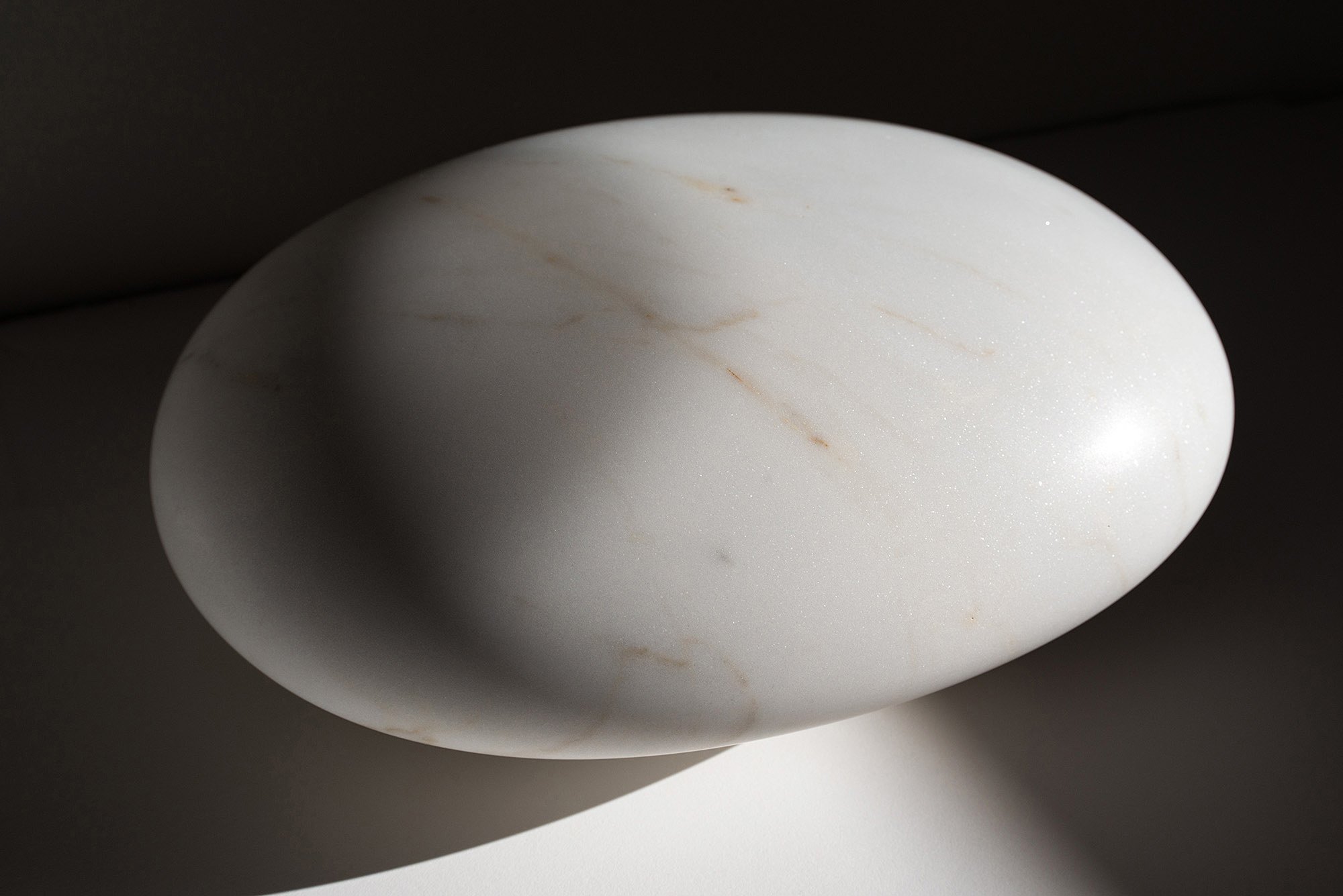FLOWSTONE
Pietrasanta, Italy
Part of the ongoing project Elements for a Light Garden
Supported by the Ontario Arts Council
White marble from Carrara (salvaged), sunlight, shadow
2021
“They lived in an enormous present, which also contained past and future. They flowed in and out of a continuum of everything around them; just as the animals flow into and out of the rock…And perhaps this is what truly separates us: not the space of time, but the sense of time.”
Flowstone is a contemplation of light and timelessness in elemental chiaroscuro. The sensuous minimalist form was created to cultivate sunlight and shadow on stone, reflecting on the deep time interrelationships intrinsic to the marble—the essence of its past, present, and future.
The marble was hand carved and shaped with circling movements, slowly arriving at an elemental form that embodies something of the primordial matter of the marble itself; a trace of the stone’s origins from across the mists of geologic time, some 300 million years ago (1). Illumination surfaces through circulating veins of minerals such as mica, pyrite, and iron oxides. Soft ovoid curves recall the bodies of prehistoric marine animals of an ancient sea—the calcareous shells of molluscs, coral, and crustaceans—transformed by metamorphism into a dense mass of sparkling calcite crystals, ultimately becoming marmo (marble).
The slow tide of the sun’s light approaches the elliptical form, releasing a chromatic wave of shadow like the dark side of a celestial body. Light and shadow find movement in symbiosis. From the revelation of the sun’s rays, the penumbral shadows that arch into the cool surface, and the elliptical umbra, phases of chiaroscuro translate light into a cosmic landscape, composing a dynamic light memory on stone like some otherworldly sundial. Ultimately, Flowstone is an energetic sculpture “carved” by light each day—flowing and transforming with the cycles of time, recalling the primordial origins of the marble itself.
First illustrated in Galileo’s 17th century sepia watercolour drawings of the moon (2), the crepuscular phase of light between the terminator line of day and night on the moon is also known as the twilight zone. In speleology, the same term describes the point of passage where one leaves daylight and enters the liminal space of delicate light at the mouth of a cave. In Underland: A Deep Time Journey, Robert Mcfarlane recounts such a sensorial duality upon visiting a cave system: “I have, again, a powerful sense of this landscape as one in which geology both produces and confirms ways of feeling. Here in this hollow terrain…historical memory behaves like flowing water...Here in this topography of cavities and clandestine places, dark pasts get hidden, then brought to the light again” (3). Moving within the intimacy of sun and shadow elicits a sense of timelessness, as if crossing thresholds suspended in time across physical and psychological geographies, arriving at a sensation of cyclical flow within light and dark, past and future.
Karen Miranda Abel first travelled to Pietrasanta, Tuscany, in the summer of 2019 to encounter the essence of Carrara marmo in its place of origin, where artists and stone masons have cultivated a deep understanding of the stone’s particular character for more than two millennia. Located near Carrara, Pietrasanta is internationally known as a city of artists, having deep roots in Italy’s legacy of art and a colony of international contemporary artists. Pietrasanta famously attracted master sculptor Michelangelo Buonarroti, who came to work with the region’s exquisite marble more than 500 years ago. Twentieth century artists Louise Bourgeois, Isamu Noguchi, Barbara Hepworth, and Henry Moore were similarly drawn to Pietrasanta to work with marble.
Flowstone is part of project titled Elements for a Light Garden. It was hand carved in Tuscany from an old, remnant block of statuario (statuary) marble from Carrara—its surface marked with an aged patina and several fractures. The seasoned stone was one of the last pieces from a long-ago abandoned quarry, sourced from one of the oldest family owned stone merchants in Pietrasanta.
Intro. McBurney, Simon. "Herzog’s Cave of Forgotten Dreams: The Real Art Underground." Guardian, 17 March, 2011. In Macfarlane, Robert. Underland: A Deep Time Journey, Penguin Books Ltd., 2020, p. 425.
1. Kligfield, R. et al. "Dating of deformation phases using K-Ar and 40Ar/39Ar techniques: results from the Northern Apennines." Journal of Structural Geology, vol. 8 (7), 1986, pp. 781-798.>
2. Edgerton, Samuel Y. "Galileo, Florentine 'Disegno,' and the 'Strange Spottednesse' of the Moon." Art Journal, 44(3), 1984, pp. 225-232.
3. Macfarlane, Robert. Underland: A Deep Time Journey. Penguin Books Ltd., 2020, p. 217.
The Ontario Arts Council is gratefully acknowledged for funding this project












